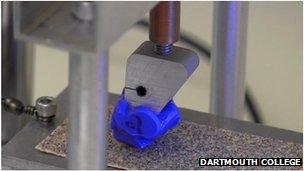Artificial finger tests evolutionary origin of prints
- Published

It seems intuitive that fingerprints should have something to do with grip, but showing this has not been easy.
Many experiments that have run human skin across various surfaces have found few if any friction benefits from the little lumps and bumps.
But new tests using an artificial finger may provide some fresh insight.
A Dartmouth College team took its mechanical digit into the field and ran it over natural materials like tree bark and found a big friction increase.
The observation is interesting because it could say something quite deep about the evolution of primates.
Nathaniel Dominy: There has been a lot of interest in why these ridges look the way they do
Only our order of animals, with a few exceptions, has these ridges, or dermatoglyphs, on the ends of fingers and toes.
The research would suggest therefore that the prints gave our ancestors a unique advantage as they clambered through ancient forests.
It is striking, says Dartmouth's Nathaniel Dominy, that the advantage shows up particularly well when natural materials are used in the experiments. Previous laboratory tests have tended to use many fingers moving across a smooth standard surface, such as a glass.
In the Dartmouth approach, it is the finger that is the control and the substrates that are varied.
Biology matters
"If you take biological materials like tree barks, something that primates are regularly gripping with their hands, we find that when the bark is being rubbed across our artificial finger there are big friction differences associated with orientation.
"In fact, the coefficient of friction increases by about 50%," said Dr Dominy.
He was talking about his work here in Boston at the annual meeting for the American Association for the Advancement of Science (AAAS).
The artificial digit has a pad made from silicone to mimic the way the skin on the end of a finger moves and stretches as it drags across a surface.
Impressed upon this pad are print designs produced by the Dartmouth, New Hampshire, team.
The whole apparatus is small enough to take outside the lab to locations with natural materials with interesting textures.
"We're finding that when you rub a natural biological surface that has an orientation - that has a grain, if you will - and you run that grain perpendicularly to the long axis of the ridges, we find a dramatic increase in friction," Dr Dominy told BBC News.
"This stands in stark contrast to earlier studies that found the orientation of rubbing really didn't matter, and that lack of difference has been a line of evidence that some people have used to argue that friction cannot be the explanation for the ridges.
"Our data differ from those earlier studies because we're finding that on a biological surface, a rough surface, that orientation does matter."
What is suggested to be at work here is the concept of asperities - the idea that if you take two rough surfaces and rub them together, the peaks in one will couple with the troughs in the other, increasing friction.
Jonathan.Amos-INTERNET@bbc.co.uk and follow me on Twitter: @BBCAmos
- Published9 January 2013